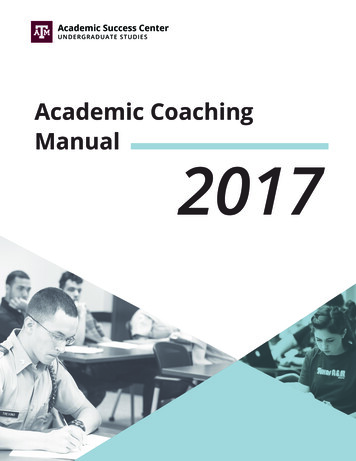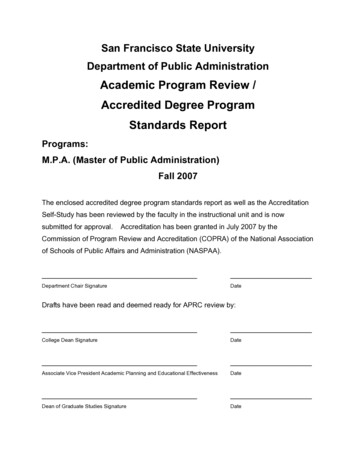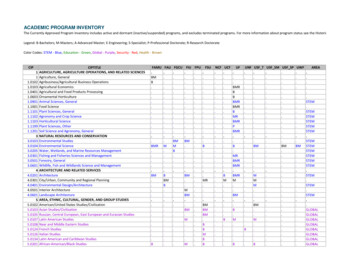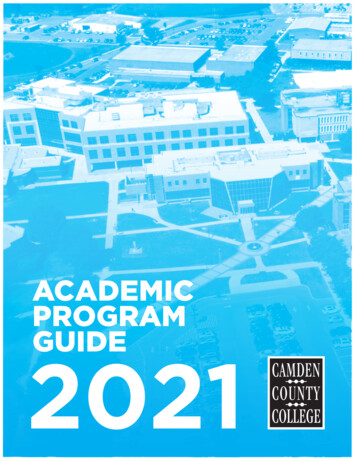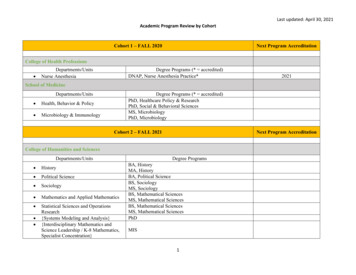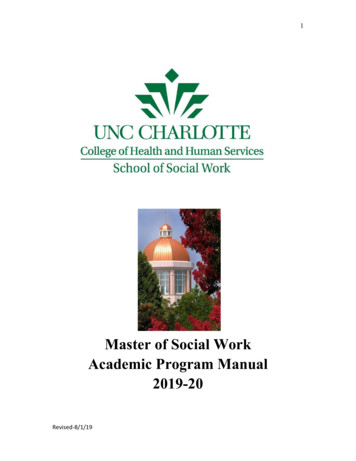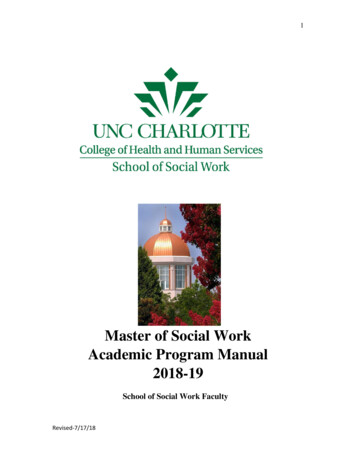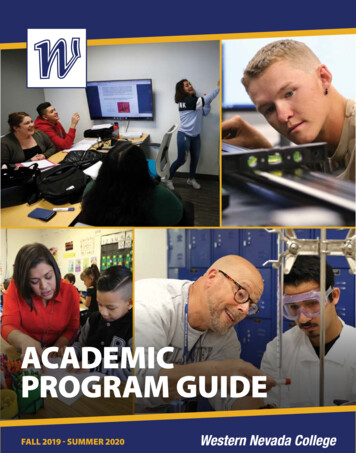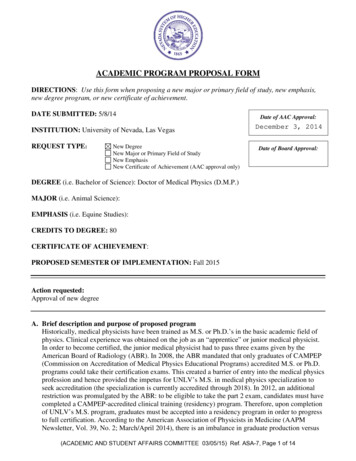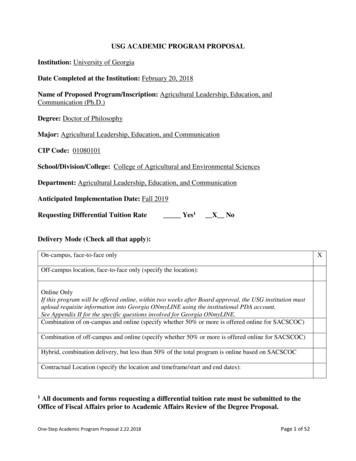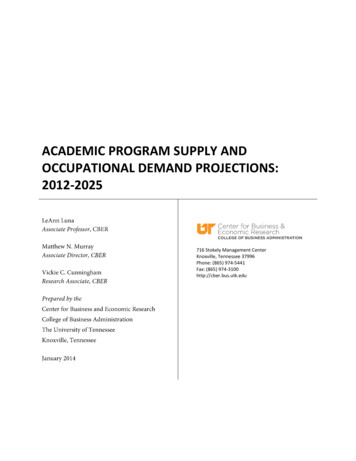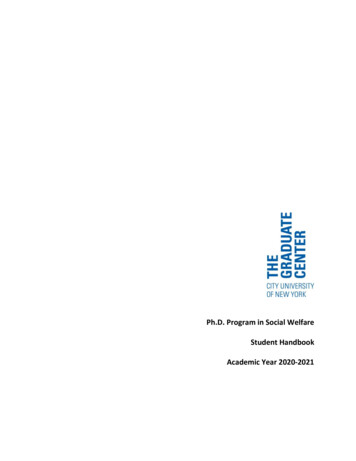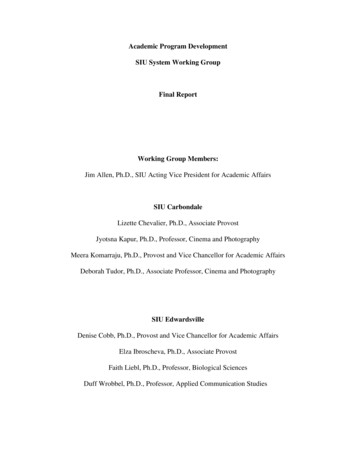
Transcription
Academic Program DevelopmentSIU System Working GroupFinal ReportWorking Group Members:Jim Allen, Ph.D., SIU Acting Vice President for Academic AffairsSIU CarbondaleLizette Chevalier, Ph.D., Associate ProvostJyotsna Kapur, Ph.D., Professor, Cinema and PhotographyMeera Komarraju, Ph.D., Provost and Vice Chancellor for Academic AffairsDeborah Tudor, Ph.D., Associate Professor, Cinema and PhotographySIU EdwardsvilleDenise Cobb, Ph.D., Provost and Vice Chancellor for Academic AffairsElza Ibroscheva, Ph.D., Associate ProvostFaith Liebl, Ph.D., Professor, Biological SciencesDuff Wrobbel, Ph.D., Professor, Applied Communication Studies
The charge of this committee, and the purpose of this report, is to consider ways in whichthe SIU campuses, particularly the campuses of SIUC and SIUE, can collaborate to promoteacademic opportunities for prospective students, share curricula, and identify mutually beneficialactivities that will also serve the region. With authentic and meaningful commitment fromcampus leadership and faculty, there are significant opportunities and benefits that could begained by leveraging resources and collaborative possibilities. It will be important that theSystem Office, particularly the Vice President for Academic Innovation, Planning, andPartnership, and President provide leadership and support for removing barriers and addressingthe independent concerns of each campus. More importantly, these possibilities will not beachieved without earnest and open communication of concerns, small wins, and greater trustamong the campuses. We offer these suggestions with the hope that these possibilities andopportunities can be realized, while recognizing the process and work will have its challenges.It is tempting to simply provide a list of strong programs on each campus that we believeshould be preserved or could be expanded to the other campus to the benefit of all, and even alist of known growth areas we could venture together. However, we believe that doing this,while aspirational, is not a sufficient first step. We do, however, recognize there are uniqueacademic strengths at Carbondale and Edwardsville and opportunities for expansion at both.We have included areas of strength and planned programming at the two campuses in AppendixA and B, representing Carbondale and Edwardsville respectively. We strongly encourage thenew Academic Vice President to ensure greater communication and coordination. For example,most recently, there was a significant missed opportunity for coordination with the SIUCDoctorates in Physical Therapy and Occupational Therapy (DPT and DOT), which could beaddressed with greater communication and coordination going forward. Similarly, when SIUE2
added an online option to its existing flex program MBA, it would have been useful to have priorcross-campus discussion so that the new opportunities with Academic Partnerships might havebeen considered across the System or collaborative possibilities within the existing MBAs couldhave been discussed. Regardless of where a new program opportunity originates, there may becollaborative opportunities that could strengthen new programs. Nevertheless, such coordinationshould not deter the individual campuses from serving their regional needs, building upon theirstrengths, and fulfilling their missions. Additionally, there are potential industry and communitypartnerships that might be more fully leveraged together, rather than independently. Theseopportunities need dedicated attention, nurturing and facilitation.The bulk of this report will focus on the following: Curricular and Course-Sharing Domestic Field Study Experiences and Exchange Programs Coordinated Programming Building Pathways to Advanced Degrees, particularly equity-minded pathsCurricular Collaboration and Course-SharingWe will begin by considering what curricular sharing across two campuses might looklike, and in particular, explore the structural, procedural, technical, and even cultural challengesthat need to be addressed before any meaningful exchanges could be successful. It is not ourintention to solve all challenges or problems in this report. We believe that the skilledprofessionals on both campuses, once tasked, will be able to do so much more quickly andeffectively than we can. Rather, we seek to provide a road map to guide the SIU System to aplace where any proposed curricular sharing would be not only possible, but comparatively3
simple, inexpensive, and ultimately highly beneficial to both students and faculty on bothcampuses.As context, we began our meetings in February 2020, well before anyone had seriouslyconsidered the possibility of statewide campus closures due to the Covid-19 pandemic. In ourearly meetings, we began discussing which new programs we might develop jointly, whichexisting programs we might share, and what such sharing might look like. And then, the worldshifted beneath our feet and we all shifted into “pandemic mode.” A suggestion we hadconsidered prior to the pandemic was to look at the existing online courses offered on bothcampuses, and to explore the possibility that individual online course offerings found on onlyone campus be opened up to students on the other. As an example, both SIUC and SIUE have aCommunication Studies program and offer a Public Relations specialization/track. OnlyCarbondale, however, has a Sports PR course, and only Edwardsville has an International PRcourse. Creating a mechanism by which PR students from each campus could seamlessly enrollin online sections of these course on the other campus would benefit students in both programs.We found a similar argument could be made about many programs. The only problem was theprevious lack of courses ordinarily on-line during the Fall and Spring semesters. As one mightimagine, this is no longer true and is unlikely to be the case moving forward, as an entiresemester’s worth of course inventory on both campuses is now, at least, partially developed foronline or remote delivery, as a response to Covid-19. Faculty who had no interest in makingsuch a move have now made that emergency transition, which has led to building new onlineopportunities for the ’20-’21 academic year. Moreover, departments reluctant to expend the timeand resources have now done so. Classes that were too hard or “impossible” to move onlinehave been moved there anyway. Had our committee lobbied for this, it would likely never have4
happened, but given that it has, we propose taking full advantage of the new capacities andlearning opportunities to strengthen our programs and enhance the student experience andopportunities.Let us now consider some of the issues that will need to be addressed in order to shareonline curricula across campuses. We recognize this section needs to be reviewed for topicaddition/subtraction and topic sequence, then expanded through future committee’s efforts: MarketingTechnology compatibility and software/hardware requirementsAdvisingFinancial Aid Flexibility/VersatilityConsistency or System Tuition & fee RatesReciprocity and Exchange Relationships that can be monitored over timeEnrollmentProgram and University transfer policies or Consortium agreementsAcademic CalendarsCourse schedulingOutcomes/competencies alignments/ Program reviewsFTEsTranscriptingWhile this list seems daunting at first glance, it should be noted that there are already anumber of programs that have successfully navigated many of the issues above and other publicUniversity systems that provide exemplars (e.g. University of Illinois, Indiana University PurdueUniversity Indianapolis). A clear example within the SIU System is our shared experience withcooperative Ph.D. programs. We already have both an application process, and a mechanism foraddressing tuition and fees across campuses.Both campuses have students who are dual majors, so we have mechanisms for dealingwith shared head counts. Both campuses have 2 2 programs with area community colleges, 3 2accelerated Master’s programs, and interdisciplinary major programs that provide expandedmodels for sharing curricula. In addition, both campuses have successful international5
reciprocity agreements with campuses across the globe. We are confident that if we cansuccessfully partner with international universities, we can do so with one another within theSystem. Finally, we are aware of many consortia arrangements accredited by the HLC that wecan look to for best practice models to fill in any gaps as we move forward.Recommended Action Steps:Form an inter-campus committee that can work through relevant issues to createstreamlined opportunities for students and address the issues above. Identify select programs topilot in Spring 2021 and Fall 2021. Additionally, the group should identify a list of courses thatcould be shared over time with regularity and ease. We believe there are additional opportunitiesto build collaborations between the two campuses to offer badges (credit and non-credit) andstackable micro-credentials, building on the unique strengths of each campus.One place to start would be with the Honors Programs at each campus. Honors Programscan be imagined as test-beds for broader innovations. The Honors Programs at SIUC and SIUEcan explore collaborating on curricular and programmatic initiatives, which would further oursystems advantage of location in both an urban and rural setting. The curriculum in Honorseducation is integrally connected to holistic education involving interdisciplinarity, service, andactive learning opportunities. For instance, both programs could cohere some of their coursesaround a theme. Themes of interest circle around sustainability in the broadest sense, of bothour environment and humanity. We could pick the same theme and coordinate a distinguishedspeaker series and service opportunities for students on both campuses. We could work onprojects that involve both campuses. For instance, both campuses share a common history inBuckminster Fuller’s ideas about society, technology, and education. We can also expand ourcurricular offerings with virtual and mixed modes of teaching.6
The directors of the Honors program on the respective campus have already established ameeting schedule and a pilot for course sharing in Fall 20-21. In Fall 2020, SIUC Honors isoffering Intercollegiate Athletics, a course taught by President Dan Mahony and D. Bobbi Knapp(Associate Professor, Kinesiology) to both SIUC and SIUE students. Both Drs. Knapp andMahony were given 0% appointments in SIUE. We are now working towards creating a courseto be offered by Dr. Jeffrey Manuel, Associate Professor of History from SIUE on the historyand culture of the Mississippi River that students on both campuses will be able to take. There isa lot of enthusiasm about curricular collaboration. However, the details of cost sharing are morecomplex. Yet, as a pilot this has been a really energizing project to work on.Domestic Field Study Experiences and Exchange ProgramsBoth campuses have forged significant and powerful international exchangerelationships. In these relationships, students receive opportunities to learn in new environmentswith institutional partners abroad. We create reciprocity agreements such that students pay thehome institution’s tuition and attend the partner institution, with no transfer of funds in manycases. We argue that similar kinds of exchanges could occur to provide students residentialopportunities in Edwardsville and Carbondale when exchange relationships are codified. Thelocations of each campus and the distinctive partnerships (e.g. corporate, community, etc.)provide unique learning opportunities that could be enriching for student learning andengagement.Recommended Action Steps:A working group would develop procedures and templates to facilitate the developmentof exchange relationships within the system that do not require overly bureaucratic processes ofadmissions, financial aid, tuition differences, scholarships, etc. Student-centered solutions that7
remove these barriers in similar ways to international partnerships are warranted andadvantageous.Coordinated and Cooperative ProgrammingThere are opportunities to imagine new ways of launching and sharing programs andopportunities for students to optimize resource expenditures and maximize student opportunities.For example, when SIUC submitted its proposals to IBHE for the Physical Therapy andOccupational Therapy programs, SIUE’s faculty had spent a year planning and developingproposals for the same programs that were ending their journey through the internal sharedgovernance processes. Without coordination, the System loses an opportunity to think morefully about how to meet the needs of the individual regions of the campus and the broader state.Recommended Action StepsWe encourage the President’s Office to build greater collaboration, find creative andmutually beneficial solutions, and to enhance enrollment across the system. For example,consider how new degree programs are approved. A proposal for a new academic program usesthe format of a new unit of instruction (NUI) and a notice of intent (NOI). The NOI is posted byIBHE for at least 30 days prior to any Board action, and remains active for one year after thepublic posting period has expired. At one point in time, NOIs were submitted in advance ofsubmitting the NUI in order to notify others and received feedback/comments. Returning to thispractice would facilitate communication between our campuses. Any adjustments should notslow down the processes that can already be cumbersome. If the communication does not occurearly in the process, then faculty resources, including their hard work and creativity, could beimpeded at the late stages, and we would like to avoid such practices.8
We also encourage a working group to explore options for cooperation and collaborationamong degree programs across each campus. This working group would also be able to identifyopportunities to grow new areas of academic programming to serve regional and national needs.For example, we could explore new opportunities to build new interdisciplinary groups byrecognizing unique courses and scholarship in complementary programs such as chemistry,fermentation science, food science, agriculture, nutrition, political science, and health relateddisciplines.Recommended Action Steps:Form an inter-campus committee that can identify strategic opportunities to buildcollaborative programs that would not be easily achieved independently but would add value forstudents and regional employers. The working group should also examine possibilities forconcurrent degree programs that are not yet in place. These should be examined across thesystem, including the SIU School of Medicine and SIUE School of Dental Medicine.Building Pathways to Advanced Degrees, particularly equity-minded pathsWe propose developing coordinated pathways to graduate degrees. Individually,campuses offer accelerated pathways from undergraduate to master’s programs in a number ofdisciplines. The discussion often starts when students are involved in initiatives that exposethem to research. Both campuses have programs that promote these opportunities (SIUE URCA,SIUC REACH). In addition, SIUC has a McNair program and both campuses have hosted anNSF REU program. There are currently four cooperative PhD programs between the SIUE andSIUC and one between SIUE and the SOM that provide a pathway for graduate studies at thedoctoral level. In addition, a number of the doctoral programs at SIUC have direct entry optionfor high achieving undergraduates. Expanding these pathways system-wide for PhD and9
Professional Doctoral programs would provide interesting and important avenues forrecruitment. In addition, we are committed to working in equity-minded ways that build andsupport pathways programs that are specific to recruitment of students who are historicallyunder-represented in higher education, including Black/African Americans, Hispanic/Latinostudents, first-generation students, and people with disabilities.It cannot be understated that the mission statements of both campus respect and supportthis goal.SIUE Mission:Southern Illinois University Edwardsville is a student-centered educational communitydedicated to communicating, expanding and integrating knowledge. In a spirit ofcollaboration enriched by diverse ideas, our comprehensive and unique array ofundergraduate and graduate programs develops professionals, scholars and leaders whoshape a changing world.SIUC Mission:SIU embraces a unique tradition of access and opportunity, inclusive excellence,innovation in research and creativity, and outstanding teaching focused on nurturingstudent success. As a nationally ranked public research university and regional economiccatalyst, we create and exchange knowledge to shape future leaders, improve ourcommunities, and transform lives.These kinds of opportunities could be explored for first-professional doctoral programs aswell. For example, beginning with the class of 2021, SIUE Honors students with any bachelor’sdegree who meet GPA and curriculum requirements are guaranteed admission to the SIUC10
School of Law. The System could also facilitate the development of pathways that originate withcommunity college partners and build new relationships with HBCU/HSI to build a pathwayfrom undergraduate programs to accelerated Masters programs on both campuses and PhDprograms at SIUC.Recommended Action Steps:An inter-campus committee with representatives from both Graduate Schools should beformed to conduct an analysis of current accelerated BS/BA to MS/MA pathways and matchthem with PhD or Doctoral programs in appropriate disciplines. Similarly, the group can lookinto establishing relationships on both campuses with HBCU/HSI undergraduate programs, withpossible focus on STEM disciplines, to create stronger and more equitable pathways for studentsfrom under represented populations to seek degrees in STEM and earn graduate degreesculminating with the PhD. A select number of programs can be identified as potential pilots withsupport from both campuses.ConclusionThis report does not address the full scope of collaborative academic programmingpossibilities. We recognize there are many additional opportunities in related areas of enrollmentmanagement, curriculum, pathways, and research and creative activities. Nevertheless, webelieve these recommendations provide a starting point and initial guidance to help enhance andsupport collaboration within the System. To realize the full potential of System partnerships, thework will need support from the President and Vice-Presidents, and will most likely benefit fromincentives and seed funding. We hope this offers guidance and direction to help facilitate thekinds of collaboration that will, ultimately, benefit our current and future students, the employersof the region, and the communities we serve.11
Appendix A: Academic Planning Working GroupTop SIUC programs that are generating strongNEW SIUC programs we may wantenrollment and that we could enhanceto grow in the future that would allow us towith more resources:increase student on and n StudiesMusical TheaterHEALTH AND HUMAN SCIENCESNursingDigital HumanitiesTherapeutic RecreationRadiologic SciencesMasters in Health AdministrationPsychologyCriminology & Criminal JusticeExercise ScienceSocial WorkAGRICULTUREAnimal ScienceFermentation ScienceForestryENGINEERING, SCIENCE, TECHNOLOGYB.S. in Mechanical EngineeringComputer ScienceZoologyBiological SciencesAutomotive TechnologyAviation Technology/ManagementFood Science/TechnologyHorticulture (hemp/cannabis)Fermentation ScienceBiomedical EngineeringCybersec
considered prior to the pandemic was to look at the existing online courses offered on both campuses, and to explore the possibility that individual online course offerings found on only one campus be opened up to students on the other.
